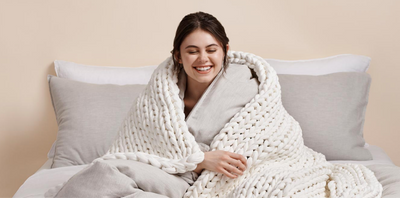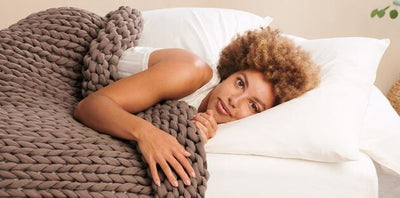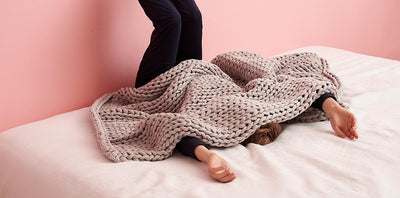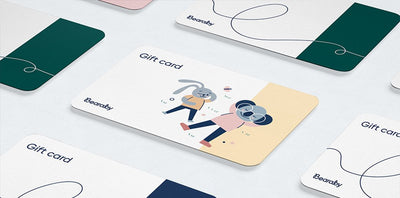The Best Frequency For Sleep, From Solfeggios to Binaural
The best frequency for sleep is in the low to mid frequency range. Some studies have found that 432 and 528 Hz have a de-stressing effect on the brain, possibly reducing cortisol levels and raising oxytocin. Binaural beats that produce very low frequencies like 4 Hz may also help with sleep.

Bearassentials
Some frequencies may help with sleep by aiding the brain in balancing neurotransmitters like cortisol.
There are many Solfeggio frequencies, but the best studied ones for sleep are 432 and 528 Hz.
Binaural beats are also promising. By having two separate frequencies in each year a third frequency is produced by the brain.
Did you know?
Humans can’t detect frequencies below 20 Hz, but they can still damage your ears. Fortunately, you can detect the volume of your low frequency binaural beat by listening to either headphone.
Looking for the perfect sound to get you to sleep? Wondering if the answer to your snoozing troubles is less lullaby and more science-based?
There’s a growing body of research digging away at these questions, but aside from leaning towards low-frequency sounds, the best frequency for sleep is still up for debate.
Binaural beats may be one solution, the solfeggio frequencies could be another. And within each category there are several variations, all of which have the potential to take you off to a deep, cozy slumber
How Does Listening To Frequencies Help Sleep
Knowing a bit about sound can make it easier to understand how listening to frequencies helps with sleep.
The important thing to know is that everything you hear is the result of sound waves interacting with the air around you. When you pluck a guitar string these waves travel through the air and hit your ear drum.
The more waves over a given interval, the higher the frequency. This is typically measured in hertz (Hz) and is commonly referred to as ‘pitch.’
How do invisible waves affect your ability to catch those precious Z’s? Scientists have theorized that certain frequencies, especially ones in the lower range, can help by:
- Lowering cortisol levels, producing a calming effect.
- Blocking out disruptive sounds that can be distracting.
- Having an effect on the immune response.
However, research is still in the early stages and none of these benefits are considered conclusive yet.

Different Frequencies That May Aid Sleep
When looking for frequencies that can help you conk out at night, it’s best to look toward the lower end of the spectrum. If the sound is too high-pitched, it can be harsh and have a distressing effect. Think of the classic music from Alfred Hitchcock’s movie Psycho.
Go even further than that (past 20 kHz) and the human ear can no longer even register the sound.
On the opposite end of the spectrum, there are lower-pitched, lower frequency sounds in the 20-500 Hz range. Listening to sleep music or ambiences in this range can have a calming effect for some.
There are also specific Frequencies that are thought to have more specific benefits that go beyond science. These are known as Solfeggio frequencies.
Best Solfeggio Frequency For Sleep
Solfeggio frequencies are a list of sounds that are tuned to specific frequencies. They’ve been around for a long time, specifically in ancient religious circles, and saw a revival in the 1970s when Dr. Joseph Puleo began researching their potential for natural healing.
The number of Solfeggio frequencies varies depending on the source, but there are typically at least six in any list. Each one has a different supposed benefit, some more spiritual than others:
- 396 Hz – Relieves fear and guilt
- 432 Hz – Allows greater connection with nature
- 528 Hz – Heals and repairs the body
- 639 Hz – Balances mood and emotions
- 741 Hz – Helps with problem solving and self-expression
- 852 Hz – Helps replace negative thoughts with positive ones
Many of the reported benefits are lacking any scientific evidence, but some of them do have research to back up their claims.
432 Hz Frequency
Possibly the most studied of all of the Solfeggio frequencies, 432 Hz comes with the potential to relieve anxiety and help you get to sleep quicker.
One study from 2019 examined 15 males and the amount of time it took them to fall asleep while listening to 432 Hz music. It concluded that, based on brainwave activity, “432 Hz music has some significant calming effect.”
528 Hz Frequency
Another of the most studied Solfeggio frequencies, 528 Hz helps sleep via a similar de-stressing effect on the mind. In particular, it helps to regulate cortisol, the stress hormone, and oxytocin, sometimes called the love drug.
One Japanese study from 2018 compared 528 Hz music to 440 Hz, measuring these hormones. It found that what 528 Hz does to the brain is lower cortisol and raise oxytocin. 440 Hz had no measurable effect.
The Best Frequency For Sleep
If you’re looking for a specific frequency that’s best for sleep and healing, it’s likely either 432 or 528 Hz. However, the truth is that this is still a very under-studied field and there haven’t been many notable results as far as healing goes.
Still, these may be some of the best frequencies for sleep manifestation as they can reduce stress, making it easier to fall asleep. Some studies have found that the 432 Hz sound works by blocking out unwanted external sounds. This could be promising for insomnia patients as the condition can be related to brain hyperactivity.
Binaural Sounds For Sleep
Sometimes two really is better than one, and that may be the case when looking for the best frequency for sleep. Binaural beats are just that, combining two very different sounds that may give your brain a boost when used properly
The key word there is ‘properly.’ That’s because you need to have a different frequency in each ear, usually accomplished with headphones rather than speakers. Your brain then takes the difference and creates a new sound.
For example, if you have a 420 Hz frequency in one ear and a 400 Hz frequency in the other, your brain will create a third sound at 20 Hz to make up the difference
These are often white or ambient sounds, and the result is auditory beat stimulation (ABS) which can produce changes in brain wave activity. A 2015 research review found that this phenomenon can lead to anxiety relief, though the mechanisms aren’t completely understood.
Another study from 2005 published in Anaesthesia found that these binaural beats helped relieve pre-operative anxiety ‘significantly.’

The Best Binaural Sound For Sleep
What binaural sound is best for sleep is still up for debate, but it’s possible to guess based on the different brain waves they’re capable of producing in humans. There are six main brain wave types to consider:
- Gamma: 30-50 Hz
- Beta: 13-30 Hz
- Alpha: 8-12.99 Hz
- Theta: 4-7.99 Hz
- Delta: 1-3.99 Hz
Gamma, beta, and alpha are all associated with different levels of wakeful states. Because of that, theta (sleep stage 1 and 2) and delta (stage 3, or deep sleep) may be better targets when trying to fall asleep
Because of that, you may want to give a binaural beat with a resulting frequency of less than 8 Hz a try. And dropping down to the delta range of 1-3.99 Hz could be the best frequency for deep sleep
Cotton Napper

Dreamy, buttery softness
Calms body & mind for deeper sleep
Hand-knitted huggable comfort
It's Napper Time
FAQs
Still have questions about the best frequency for sleep? Here are some of the common ones and their answers.
What Is 528 Hertz Good For?
Studies are still in preliminary stages, but the 528 hertz frequency may be good for lowering stress levels. One Japanese study found that when compared to a slightly lower frequency, those who listened to 528 hertz had lower cortisol levels and higher oxytocin levels.
Of course, lower levels of stress has many other benefits, like the potential for improving sleep. Using it at the start of the night may help reduce the amount of time it takes to fall asleep
Can Pink Noise Help You Sleep?
Pink noise can help you sleep just like many frequencies, music genres, and ambiences can. The blend of frequencies may help to eliminate distractions from outside influences, allowing you to feel calmer at night.
Some compare pink noises to nature sounds, which also may also be beneficial to stress responses such as heart rate and blood pressure. It’s produced by including all audible frequencies and sometimes increasing certain pitche’s volumes
Does Low-Frequency Help Sleep?
Some theories suggest that low frequency sounds may help with sleep because they’re similar to the brain waves you produce during sleep.
As our brain relaxes, it produces alpha waves at a frequency of 8-12.99 Hz. The first two stages of sleep are associated with theta wave forms (4-7.99 Hz), and during deep sleep our brains form delta waves (1-3.99 Hz).
All of these are inaudible to humans, but some research suggests that playing them may help our brains produce the waves
Conclusion
The best frequency for sleep is still being studied, but some of the promising ones are frequencies like 432 and 528 Hz, sometimes called Solfeggio frequencies. Listening to these may eliminate outside distractions and lower stress responses in the brain.
Binaural beats are another area with a lot of potential. By combining opposing beats very low frequencies that are normally seen during the stages of sleep can be reproduced in the brain. This may help relieve anxiety and make quality sleep a little easier to get.






